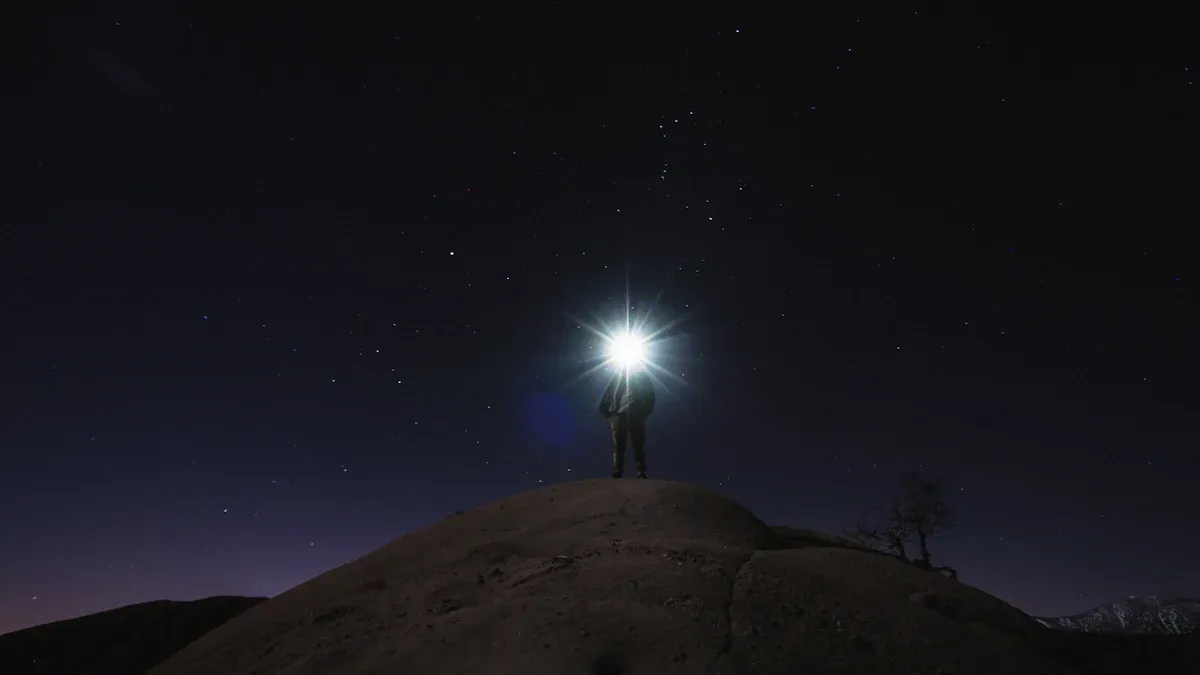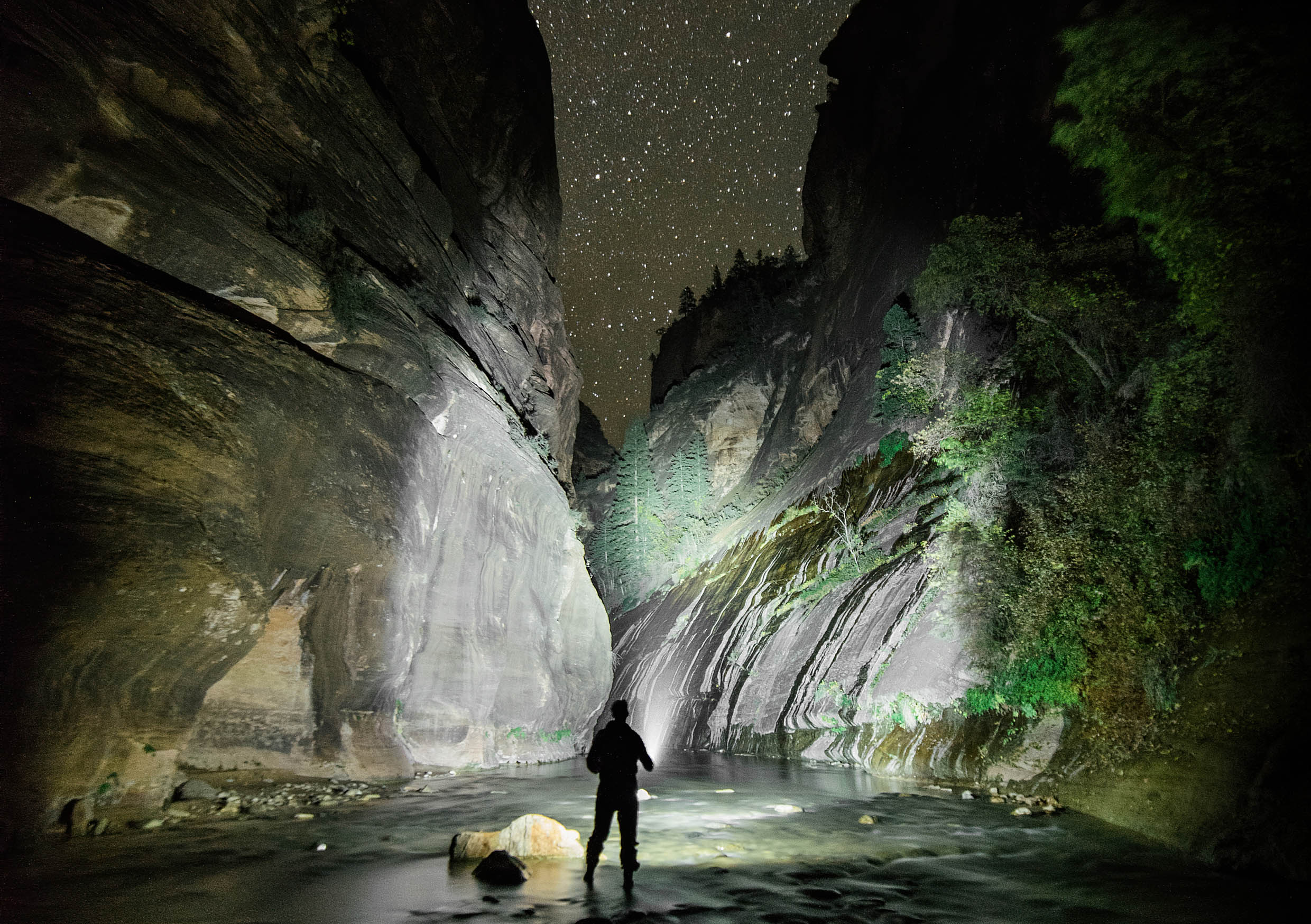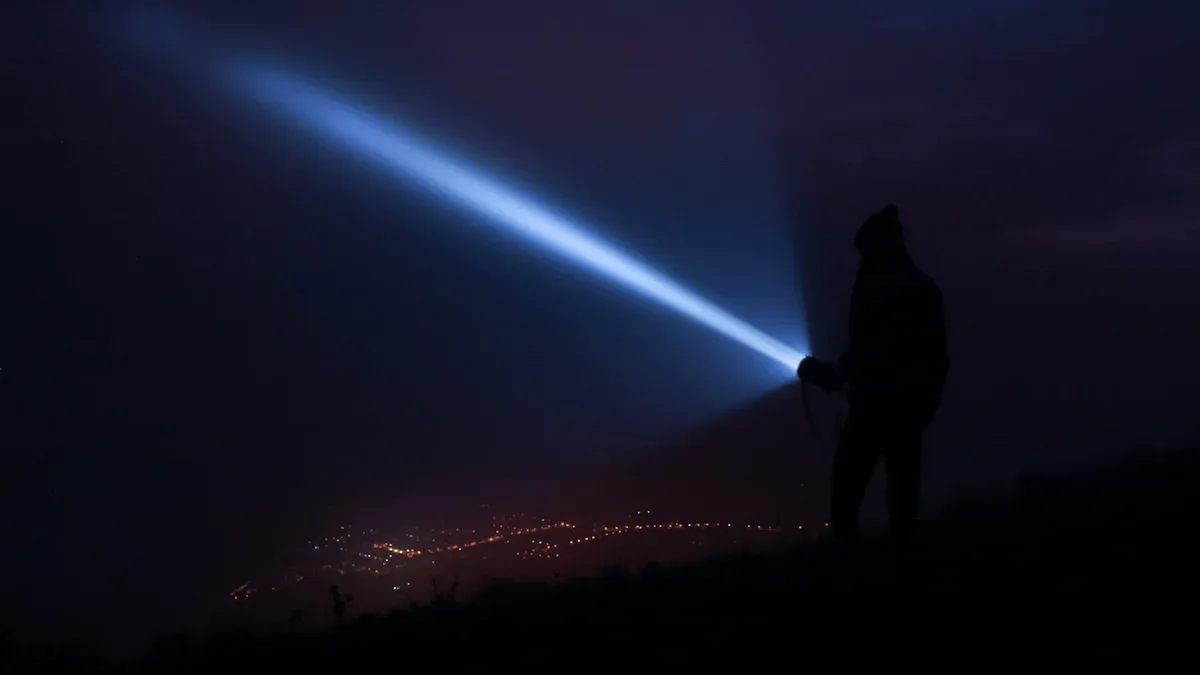How to Select the Right Flashlight for Any Situation

When you flashlight choose, understanding your specific needs is crucial. Choosing the right flashlight means prioritizing reliability, efficiency, and durability. Opt for models with energy-efficient LED bulbs to ensure longer runtime and materials like aluminum alloy for enhanced drop resistance. Many users focus on factors such as quality, price, and ease of use. Flashlight choose wisely by carefully considering these aspects, and this guide will help you find the perfect flashlight for your needs.
Key Takeaways
Think about what you need before picking a flashlight. Look at things like brightness, strength, and battery type to make sure it fits your needs.
For outdoor use, pick a flashlight with 200-1,000 lumens and water resistance. Different light modes make it useful in many situations.
Check how strong the flashlight is made. Aluminum and stainless steel are tough materials that work well in rough conditions.
How to Choose Flashlight Based on Purpose
Everyday Use
For everyday use, you need a flashlight that balances convenience and functionality. Compact flashlights are an excellent choice for daily tasks. Their small size makes them easy to carry in your pocket or bag, and they are perfect for close-up work or navigating small spaces. Full-sized flashlights, on the other hand, offer a more powerful beam, making them ideal for situations like nighttime car repairs. Durability is another critical factor. A good flashlight for everyday use should withstand occasional drops or exposure to minor elements, ensuring reliability when you need it most.
Outdoor Activities and Camping
When venturing outdoors, selecting the right flashlight becomes essential for both visibility and user safety. Look for models with high durability and water resistance to handle unpredictable weather conditions. A flashlight with a brightness range of 200 to 1,000 lumens provides sufficient illumination for most outdoor activities. Beam distance is equally important, as it allows you to see further in the dark. Multiple lighting modes, such as low, high, and SOS, add versatility for different scenarios. Lightweight and compact designs enhance portability, while rechargeable batteries or the option to carry spares ensure high performance during extended trips.
Emergency Preparedness and Survival
In emergencies, a flashlight can be a critical tool for survival. You should prioritize models with long battery life and robust construction to withstand extreme conditions. Tactical flashlights, often exceeding 1,000 lumens, are particularly useful for emergency preparedness. They offer long-range visibility and multiple modes, including strobe and SOS, which can signal for help. Water resistance and durable materials, such as aircraft-grade aluminum, ensure reliability in harsh environments. A flashlight with built-in charging ports or power bank functionality can also serve as a backup power source for other devices, enhancing its utility during emergencies.
Flashlight Brightness and Beam Types

Lumens and Brightness Explained
Understanding lumens is essential when evaluating a flashlight's light output. Lumens measure the total amount of visible light emitted by a flashlight. The higher the lumens, the brighter the flashlight. Different activities require varying brightness levels:
1-100 lumens: Suitable for close-up tasks like reading or finding items in a bag.
100-300 lumens: Ideal for general use, such as walking at night or performing DIY tasks.
300-500 lumens: A good choice for camping or illuminating larger areas.
500-1000 lumens: Perfect for activities like caving or search and rescue.
1000+ lumens: Designed for professional use or extreme outdoor adventures.
When selecting a flashlight, consider the environment and activity. For example, a high lumen flashlight is necessary for dark outdoor settings, while lower lumens conserve battery life during emergencies. This balance ensures you choose a good LED flashlight that meets your needs.
Beam Distance and Beam Type (Flood vs. Spot)
The beam type significantly impacts a flashlight's performance. Flood beams spread light over a wide area, making them ideal for tasks like camping or construction. Spot beams, on the other hand, focus light into a narrow, intense pattern, providing long-range visibility. This makes them suitable for activities like hiking or off-road driving.
A flood beam resembles an overhead light, illuminating a large area.
A spot beam acts like a car headlight, allowing you to see distant objects clearly.
Choosing the strongest portable beam depends on your intended use. For example, flood beams work well for close-range tasks, while spot beams excel in situations requiring long-distance focus.
Matching Brightness to Your Needs
Selecting the right brightness levels involves evaluating your specific requirements. Consider the following factors:
Intended Use: Determine whether you need the flashlight for camping, emergencies, or professional tasks.
Environment: Assess the lighting conditions. Darker environments demand higher lumens.
Personal Preferences: Some users prefer brighter lights, while others may find them overwhelming.
By aligning these factors with your needs, you can select a high-performance flashlight that delivers optimal results. Whether you need a flashlight for everyday use or extreme conditions, understanding brightness and beam types ensures you make an informed decision.
Choose the Right Flashlight Size and Portability
Compact Flashlights for Everyday Carry (EDC)
Compact flashlights are an excellent choice for everyday carry due to their practicality and versatility. Their small size makes them easy to slip into your pocket, purse, or keychain, ensuring you always have a reliable light source at hand. These flashlights enhance safety by helping you navigate dark areas and signal for help during emergencies. They also prove convenient for tasks like searching for lost items or reading in dimly lit spaces. Modern compact flashlights often feature multiple modes, allowing you to adjust brightness levels or beam distance based on your needs. Carrying one not only benefits you but also enables you to assist others in need, such as helping someone locate their belongings in the dark. When you flashlight choose for daily use, prioritize compact models with durable construction and efficient LED technology for consistent light output.
Larger Flashlights for Heavy-Duty Use
Larger flashlights are designed for situations requiring high performance and durability. These models typically offer higher lumens, making them ideal for outdoor adventures, professional tasks, or emergency scenarios. Their robust construction ensures they can withstand harsh conditions, including extreme weather or accidental drops. While they may lack the portability of compact flashlights, their superior light output and extended battery life make them indispensable for heavy-duty applications. When you choose the right flashlight for demanding tasks, consider models with adjustable brightness levels and long beam distances to meet your specific requirements.
Balancing Portability with Functionality
Finding the perfect balance between portability and functionality depends on your intended use. Compact flashlights excel in convenience and ease of carry, while larger models provide enhanced performance and durability. To choose the right flashlight, evaluate your priorities. If portability is crucial, opt for a lightweight, pocket-sized flashlight with sufficient lumens for your needs. For tasks requiring extended runtime or powerful light output, a larger flashlight may be more suitable. A good flashlight strikes the right balance, offering the features you need without compromising on quality or usability.
Flashlight Choose: Battery Type and Runtime
Disposable vs. Rechargeable Batteries
When selecting a flashlight, the choice between disposable and rechargeable batteries significantly impacts cost, convenience, and environmental footprint. Disposable batteries offer a lower initial cost and are widely available, making them a practical option for emergencies. They also have a long shelf life, ensuring readiness when stored for extended periods. However, frequent replacements increase long-term costs and contribute to environmental waste.
Rechargeable batteries, on the other hand, provide consistent performance and lower long-term costs. They are environmentally friendly and eliminate the need for constant replacements. Integrated rechargeable flashlights often feature built-in charging systems, enhancing convenience. However, they require charging infrastructure and have a limited shelf life compared to disposables.
Feature | Disposable Batteries | Rechargeable Batteries |
|---|---|---|
Initial Cost | Lower | Higher |
Long-Term Cost | Higher | Lower |
Environmental Impact | Negative | Positive |
Performance Consistency | Inconsistent | Consistent |
Charging Requirement | No | Yes |
Shelf Life | Long | Limited |
Battery Life and Runtime Considerations
Battery life plays a critical role in determining a flashlight's reliability. A good flashlight should offer long battery life to ensure uninterrupted use during emergencies or extended activities. Flashlights with higher lumens consume more power, reducing runtime. For example, a flashlight with 1,000 lumens may last only a few hours, while one with 300 lumens can operate for much longer.
To maximize runtime, consider models with adjustable brightness settings. Lowering the brightness reduces power consumption, extending battery life. High-performance flashlights often include energy-efficient LED technology, which balances brightness and runtime effectively. When choosing a flashlight, evaluate your usage patterns and prioritize models that align with your needs.
Charging Options and Convenience
Rechargeable flashlights offer various charging methods, each with its own level of convenience. USB-C fast charging is the best rechargeable flashlight option for those seeking efficiency, as it fully charges in 1-2 hours. Standard USB charging takes longer, averaging 4-6 hours, but remains a reliable choice. Solar charging, while eco-friendly, requires 8+ hours and depends on sunlight availability, making it less practical for frequent use.
Charging Method | Average Time to Full Charge | Convenience Level |
|---|---|---|
USB-C Fast Charging | 1-2 hours | High |
Standard USB Charging | 4-6 hours | Moderate |
Solar Charging | 8+ hours | Low |
When selecting the best rechargeable flashlight, prioritize models with USB-C charging for its speed and convenience. This ensures your flashlight remains ready for use, whether at home or on the go.
Assessing Flashlight Durability and Resistance

Understanding IP Ratings for Water and Dust Resistance
When evaluating a flashlight's resistance to environmental factors, IP ratings provide valuable insight. These ratings consist of two numbers that indicate protection against solids and liquids.
The first digit ranges from 0 to 6, with higher numbers offering better defense against dust and fine particles.
The second digit ranges from 0 to 8, signifying increasing levels of water resistance.
Component | Description |
|---|---|
First Number | Indicates protection from solids on a scale of 0 to 6, with higher numbers providing better protection against finer particulates. |
Second Number | Indicates protection from liquids on a scale of 0 to 8, with higher numbers signifying greater water resistance. |
For outdoor or emergency use, you should prioritize flashlights with higher IP ratings. For example, an IP68-rated flashlight offers excellent protection against both dust and water, ensuring reliable performance in harsh conditions.
Materials and Build Quality
The materials used in a flashlight's construction directly impact its durability and performance. High-quality materials like aluminum and stainless steel provide robust protection against drops and rough handling. Magnesium alloy offers lightweight durability and excellent heat dissipation, making it ideal for outdoor activities. Titanium and carbon fiber are also popular for their strength-to-weight ratio and resistance to corrosion.
Material | Benefits |
|---|---|
Aluminum | Robustness and sturdy construction for rough handling and challenging situations. |
Stainless Steel | High durability and resistance to environmental factors. |
Magnesium Alloy | Lightweight, durable, and excellent heat dissipation, ideal for outdoor activities. |
Copper | Excellent thermal conductivity, corrosion-resistant, and antimicrobial properties. |
Titanium | Lightweight, strong, and highly resistant to corrosion, adding durability in harsh environments. |
Carbon Fiber | Extremely high strength-to-weight ratio, stronger than aluminum and titanium, yet lighter. |
When choosing a flashlight, prioritize models with a durable build. This ensures long-term reliability and consistent performance, even in demanding environments.
Flashlights for Extreme Conditions
For extreme conditions, you need a flashlight that can withstand freezing temperatures, heavy rain, and rugged terrain. Look for models with waterproof and shockproof capabilities to handle wet or harsh environments. High-quality materials like aluminum and stainless steel enhance durability, while certifications such as IP ratings confirm their resistance to water and dust.
Flashlights designed for extreme conditions often feature reinforced casings or rubberized grips to protect against impacts. They also perform reliably in varying temperatures, ensuring functionality whether you're in freezing cold or scorching heat. A good flashlight for such scenarios combines durability and build quality with advanced features to meet the challenges of any environment.
Additional Features to Consider When You Choose Flashlights
Multiple Modes and Settings
Modern flashlights often come with multiple modes, offering flexibility for various situations. These modes typically include low, medium, and high brightness settings, along with specialized options like strobe or SOS. You can use the low mode to conserve battery life during extended use or switch to high mode for maximum illumination in dark environments. Strobe and SOS modes are particularly useful for signaling in emergencies or deterring potential threats.
Advanced beam control technology further enhances functionality by allowing you to adjust the beam's intensity and focus. This feature ensures that your flashlight adapts to both close-range tasks and long-distance visibility. When selecting a flashlight, prioritize models with intuitive controls for seamless mode switching. This ensures you can quickly adapt to changing conditions without fumbling in the dark.
Built-in Charging Ports and Power Banks
Flashlights with built-in charging ports provide unmatched convenience. Type-C charging, for instance, enables faster and more efficient recharging using widely available cables. This feature eliminates the need for proprietary chargers, making it easier to keep your flashlight ready for use. Some models also double as power banks, allowing you to charge other devices like smartphones during emergencies.
Improved battery efficiency in modern LED flashlights ensures longer operational lifespans, reducing the need for frequent recharging. When choosing a flashlight, look for models with reliable charging options and durable batteries. These features enhance the flashlight's practicality, especially during outdoor adventures or power outages.
Accessories like Holsters, Clips, and Diffusers
Accessories can significantly enhance your flashlight's usability. Holsters provide a secure way to carry your flashlight, keeping it within easy reach during outdoor activities or professional tasks. Clips allow you to attach the flashlight to your pocket, belt, or backpack, ensuring hands-free convenience. Diffusers, on the other hand, soften the beam, creating a wider and more even light distribution. This is particularly useful for tasks like reading maps or illuminating a campsite.
When evaluating accessories, consider their build quality and compatibility with your flashlight. High-quality accessories not only improve functionality but also extend the lifespan of your flashlight by protecting it from wear and tear. Investing in the right accessories ensures you get the most out of your flashlight in any situation.
Choosing the right flashlight involves evaluating several key factors. Focus on brightness by checking the lumen rating to ensure it meets your visibility requirements. Durability is equally important; materials like aluminum or stainless steel provide strength and resistance to damage. Battery life plays a critical role, so consider energy-efficient LED bulbs and decide between rechargeable or disposable batteries. Additional features, such as adjustable focus and multiple lighting modes, can enhance convenience and safety.
To find a good flashlight that matches your specific needs, think about its intended use, the environment where it will be used, and your personal preferences for brightness levels. Whether for outdoor activities, emergency preparedness, or everyday tasks, this guide helps you make an informed decision. Take your time to research and select a flashlight that ensures reliability and performance in any situation.
FAQ
What is the best flashlight for outdoor activities?
Choose a flashlight with 200-1,000 lumens, water resistance, and multiple modes. Lightweight designs and rechargeable batteries enhance portability and performance during outdoor adventures.
How do you maintain a flashlight for long-term use?
Clean the lens and body regularly. Store it in a dry place. Replace batteries promptly to prevent leakage. Rechargeable models require periodic charging to maintain battery health.
Can a flashlight double as a power bank?
Yes, some flashlights feature built-in power bank functionality. These models allow you to charge devices like smartphones, making them ideal for emergencies or outdoor trips.
See Also
Selecting The Perfect Headlamp Flashlight For Your Needs
A Complete Guide To Selecting The Best Home Flashlight
Finding The Ideal High Power Flashlight For You
